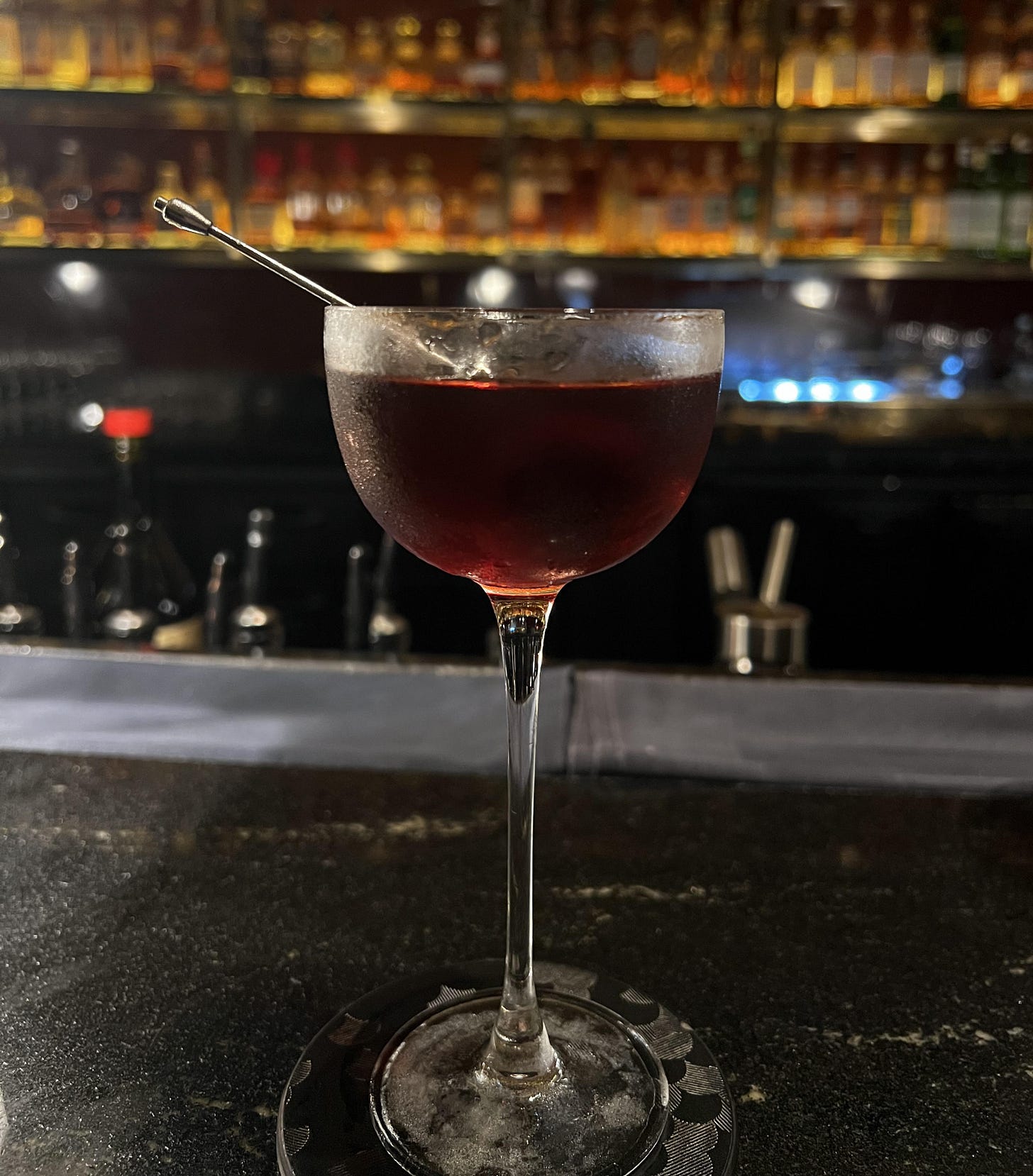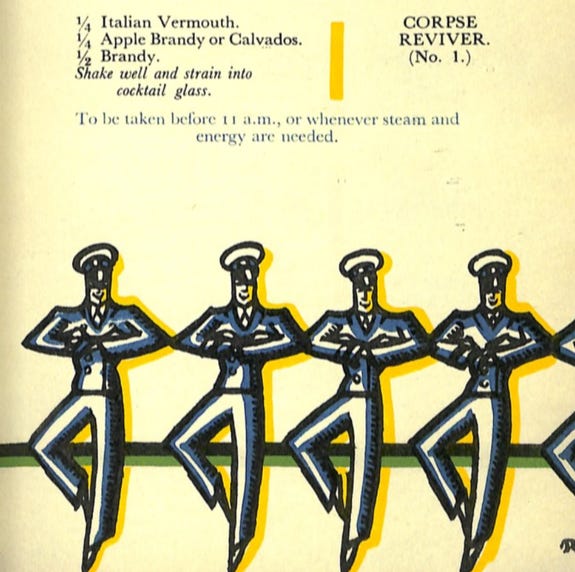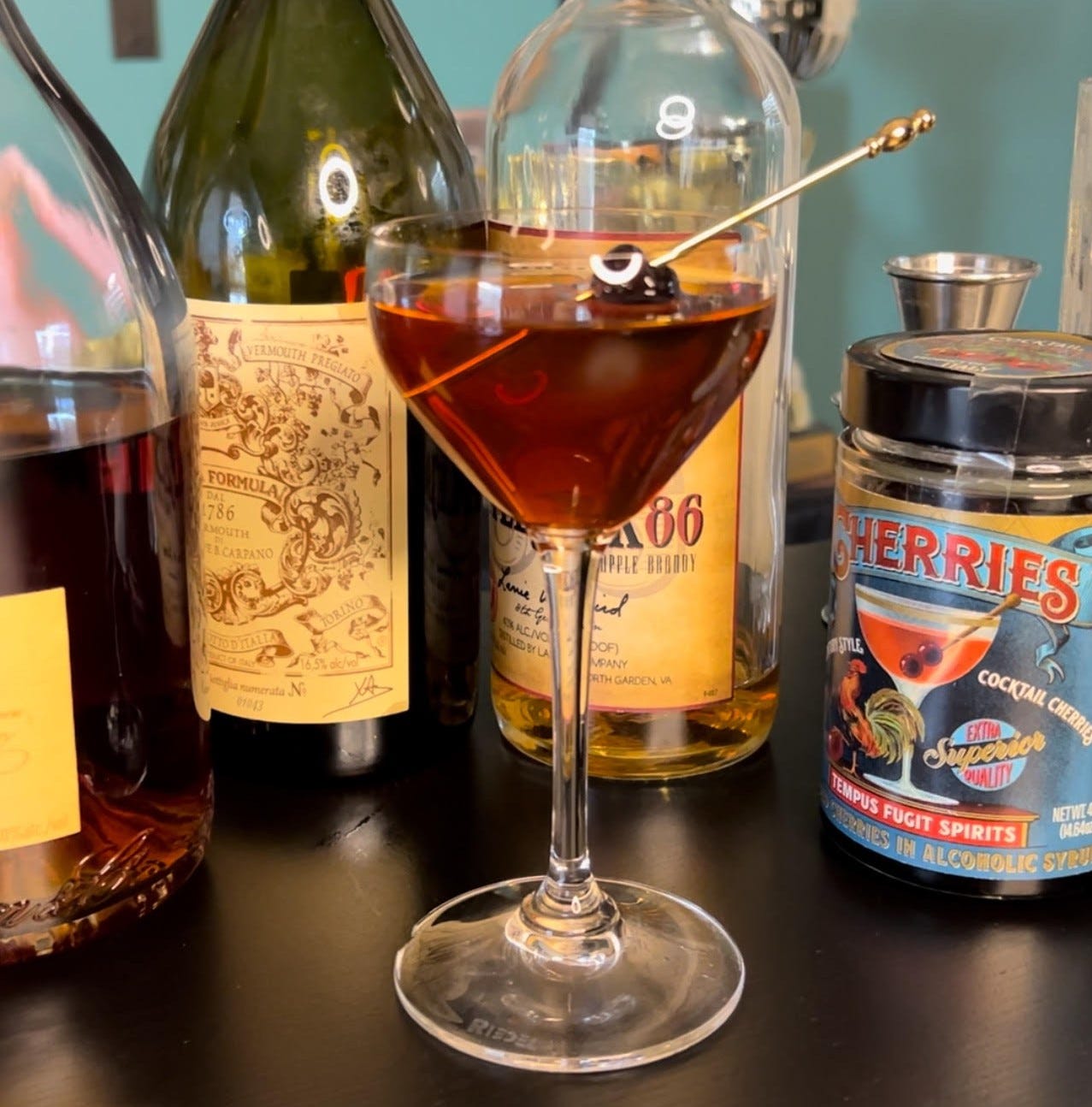At a glance:
Year Created: 1930
Inventor: Harry Craddock
First appears: Savoy Cocktail Book, 1930
Ingredients: Cognac, Apple brandy, Red Vermouth
Cocktail Family: Manhattan
There are two problems with the Corpse Reviver No. 1, and the first of them is that it sucks. The recipe, as written, is not particularly good… and the truly funny thing about the Corpse Reviver No. 1 is that this is only the cocktail’s second biggest problem.
The Story
The Corpse Reviver No. 1 has a peculiar place in the cocktail world, which is that its very existence is mostly inferred. To say that it’s been utterly and completely overshadowed by it’s kid sister (the Corpse Reviver No. 2) is still somehow to understate it, and even today, when cocktail culture has never been bigger or more popular, I’d be surprised if anyone reading this had ever even seen one.
To understand why, you need to first get at what a “Corpse Reviver” is supposed to be:
Hangover cures have evolved considerably over the last 200 years. What we know today as the Old Fashioned was the original “cock-tail,” and when it was first defined in print in 1806, it was, at the time, understood as a morning drink. That this seems frankly insane to us now is just so much cultural drift, evincing an evolving understanding of the concept of morning drinks, to say nothing of those of breakfast, productivity generally, and of sobriety itself. There were lots of names for boozy hangover cures: Phlegm-cutters, fog-drivers, eye-openers, fillips, jorums, bracers, anti-fogmatics (my personal favorite), and, most pertaining to our discussion today, corpse revivers. A “Corpse Reviver” wasn’t a specific thing, necessarily, it was just a fun and interchangeable name for a morning drink.
Harry Craddock’s hugely influential Savoy Cocktail Book published in 1930 contains two recipes for Corpse Revivers, Nos. 1 and 2, which is where these concepts get tied to specific recipes. The Corpse Reviver No. 2 is, as mentioned, the famous one — tart and invigorating, it’s bright and refreshing and one of the greatest morning drinks ever created. The Corpse Reviver No. 1, by contrast, is literally none of those things.
Corpse Reviver No. 1
The Corpse Reviver No. 1 is two parts brandy, one part apple brandy, and one part sweet vermouth, essentially a brandy Manhattan but boozier and with no bitters. Not a big editorialist, Craddock presented most of his recipes without commentary, but here offers by way of explanation just one sentence: “To be taken before 11a.m., or whenever steam and energy are needed.”
To be taken… sorry… before 11am?
Listen — I’m no stranger to the charms of day-drinking and I’ve been on my share of benders, but even at my soggiest, I have never wanted any of these things before sunset, much less before lunch. This is why the Corpse Reviver No. 1 never caught on, why you’ve never had one. The recipe is so boozy, so ill-suited for its alleged purpose, it makes you question the authority of Craddock’s whole book. I’m honestly still not 100% sure it wasn’t some kind of Prohibition-era humor that doesn't translate to modernity.
Fix up the recipe, though, and shift it a bit more nocturnal, and you’ll meet a delightful little drink. The charm of the apple brandy here is to materially differentiate the flavor profile from that of a classic Manhattan (along with the bitters, more on that below), and made right, the Corpse Reviver No. 1 is boozy but with a resonant fruity core, still full and intense like a Manhattan but less broody, and lighter on its feet.
Craddock’s proportions are lopsided. Compare his recipe as written with that of a standard Manhattan:
As you can see, there’s two obvious problems: too much booze, and no bitters. Fortunately for us, both of these are solvable.
Perfecting the Corpse Reviver No. 1
Notes on ingredients, one at a time:
Proportions: I, generally, find 3:1 (spirit:vermouth) Manhattans to be too boozy, and I still feel that way here, even with the aggressive rye whiskey subbed out for the gentler brandy. My favorite Manhattans tend to be 2.25 or even 2.5 to 1, but for this drink, I ended up preferring a 2:1 mix. Brandy is a gentler spirit, and a touch more sweetness sits better with it than with whiskey.
That said, the below recipe is on the ever-so-slightly-sweet side of acceptable, which I find more charming, but if you wanted to dry it out, feel free to add another 0.25oz of apple brandy.
Cognac: Generally speaking, younger cognac/brandy will be fruitier, often tasting like flowers, stone fruits (peaches/apricots), and a touch of raw brandy funk. With more time in barrel, the funk gets aged out but so does the fruit, and it starts to take on more leather, cigar, oak, vanilla, and spice. For this application, while more fruit would be lovely, the funk, for me, is a non-starter in something this boozy and stirred, particularly when you’re already getting some from the apple brandy. What all of this means is that you want a brandy V.S.O.P (min 4 years, but usually more) or older. Any big name VSOP or XO would work fine, as would a less-expensive but still excellent Spanish brandy like Torres 10 year or older.
Apple Brandy: I tried making this without the apple brandy, just all cognac, and it doesn’t work nearly as well. Apple brandy is where we get the fruit and a little of that funk, and how the cocktail really sets itself apart from a standard Manhattan. I’d love to save you money and tell you that you really don’t need this extra bottle, but you do.
For style: I adore Calvados, the French apple brandy from Normandy, but in this application I actually preferred the American versions. Calvados comes with a lot of rustic personality (which is the reason I usually prefer it) but in this case I thought it drew too much attention away from the other flavors, so the final cocktail was paradoxically less dynamic and interesting. As for brands, Laird’s is great, in particular their new-ish 86 proof 100% apple brandy. Clear Creek, St. George, and Rhinehall also make great American apple brandies, as I’m sure do others, but Laird’s is the one you’re most likely to find. Just make sure that it’s not the 80 proof “Applejack,” which is 35% apple brandy and 65% neutral spirits. You want it to be 100% apple brandy.
Red “Sweet” Vermouth: Some classics, like the Boulevardier, are pretty good no matter what sweet vermouth you use. This is not one of those. Of the five vermouths I tried in side-by-side tests, not only was Carpano Antica the best, but it was the best by a significant margin. It wasn’t even close. If you want to make a Corpse Reviver No. 1 well, I strongly advise it.
Orange Bitters: Craddock’s original, as mentioned, doesn’t call for any bitters at all, which gives you a drink with a strange flatness, a lack of spice and depth. You want bitters. You’d also perhaps instinctively reach for Angostura, which does indeed taste good, but the big problem is that the combination of oak-aged spirit + sweet vermouth + Angostura bitters just screams “Manhattan,” so when you use Angostura, you get something that reminds you of a Manhattan but isn’t a Manhattan, kinda like listening to a cover of a Led Zeppelin song. It may be a great cover, but all it really ends up doing is making you want the original.
Orange bitters, on the other hand, adds to the orchard fruit core of the apple brandy and makes something lighter, a little more flight of foot, in addition to being totally new and absolutely delicious. I tried with three types of orange bitters (Angostura Orange, Bitter Queen’s Odessa Orange, and Hella Orange) and Bitter Queens was my favorite, but not by such a margin that I’d buy a bottle for just this purpose. All three were good, so the lesson I take is to use whatever you’ve got.
Corpse Reviver No. 1
1.5 oz Cognac, VSOP or older
0.5 oz apple brandy
1 oz Carpano Antica Sweet Vermouth
2 dashes orange bitters
Add ingredients to a mixing glass with ice and stir for 10 to 15 seconds (for small ice) or 20 to 30 seconds (for big ice). Strain up into a cocktail or coupe glass, and garnish with a cherry.
***Over time I’ll put the paywall higher up in the article, but we’re new here, so for now, you free subscribers get almost everything. You’re just missing a juicy piece of trivia, below, so fantastically awesome it’s worth $50 in and of itself. Don’t you wish you knew what it was? Isn’t the curiosity just murder? Consider this: $50 you can get a whole year of this goodness!
In reality the trivia below is mildly interesting at best, but still, please consider subscribing. It’s how this whole thing can function. Thanks much.
Trivia: More support for the idea that the 11am recommendation was some kind of joke is this little cartoon in the Savoy Cocktail Book, found some 30 pages after the recipe for a Corpse Reviver:
To be clear I don’t think it was a joke, just shifting norms, but then again, look at that poor woman. Is this something you want to drink before lunch?







